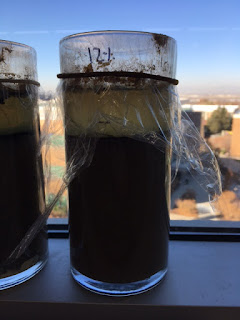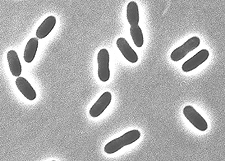GeoMicro 3753Fall 2018 Winogradsky Columns
Well, It has been 12 weeks or so since the creation of our mad experiment. We took a bit o' duck pond water, some soil stolen, umm, acquired from nearby and added a dash of sodium chlorite (that's salt; just sayin') in varying concentrations...threw in an egg to grow on... and we were off! Once in a while over the term, somebody would check in on our growing microbial high rises, take some candid photos and give us all on ongoing status update here at the Weber Geo Micro blog.
As a budding Geologist, I must admit that growing microbes in soil wasn't of much interest; however, the results are quite amazing. You notice above, we have several columns. Each column represents a percentage of sodium (there's that salt again!). Can you guess which one has no salt added to our "fresh' water and soil? (Hint: it's the one on the left with no percentage marked on it.) I am really impressed with the stratifying colors. The layers are different types of microbes, bacteria, living at on the different 'floors" of the microbe high rise. This shows how different needs can be served for different species of bacteria: ya know, like the access to oxygen, the egg nutrients (carbon and sulfur), how much sunlight they get etc.

Here's a look at the tops of the columns, the penthouse suite of the high rise! Do you see all that nice frothy growth? It seems as though the high salt content of our 12% column isn't as much of a party as the totally fresh column. Back to the stratification (layering);
Wow! The control column; that means no salt added, is really growing some layers! This a view of the room side; away from the direct sunlight. We have some nice greens, black and even a bit of yellow and white. I wonder what the sunlight side looks like?
Wow again! With the direct sunlight, the layers are very thick and penetrate the soil almost to the bottom. Down there near the egg at the bottom will be the yummy sulfur that some of the bacteria like to eat. Some times ground floor of the high rise is a party too! Let's take a look at the poor 12% saline column, shall we?
Hmm, not as exciting at all. This is the sunlight side and you can tell right away that there just isn't as much going on. The layers are very thin, except that top grey brown milky looking stuff. There is a nice black layer but once again, very thin and not penetrating the soil. It would seem that microbial community that lives in the duck pond is not to fond of salt. But also interesting is that something is growing and surviving...on little oxygen and far away from the yummy egg in the soil. even in adverse conditions, the microbial world finds a way to live. Of course, the real party is going on in the control column.
Looking back at the top photo, you can see that a rich community grows in each column until you get to the 12% saline. Granted; the diversity and richness declines at each level (4% and 8% if you were wondering). It would seem that the original question of "does the saline concentration have an effect upon the growth of bacteria in fresh water from the pond?" is answered with a resounding YES!
My scope of interpretation on what each of the layers means in term of what bacteria are growing is limited and the attention span is slim. I can reveal to you that each layer, as mentioned above, represents a particular microbe with particular needs. Some seek the sun and available oxygen, others seek the dark depths of the soil, looking for the sulfur and carbon of the egg. Some of the microbes follow the others, feeding off of the by-products of their neighbors and in their turn feeding yet other microbes. I leave the technical aspects of this experiment to my microbiologist colleagues. I am confident that in the future as I learn more about how the smallest things (microbes) affect our planet, I will remember this experiment. So I leave you, dear reader with this...Life is rich and persistent but even small changes to the conditions of that life can have profound effects. As demonstrated by the higher saline content, even adverse conditions will yield some results.
Steve Moore
Applied Environmental Geoscience
Geosciences Department







































